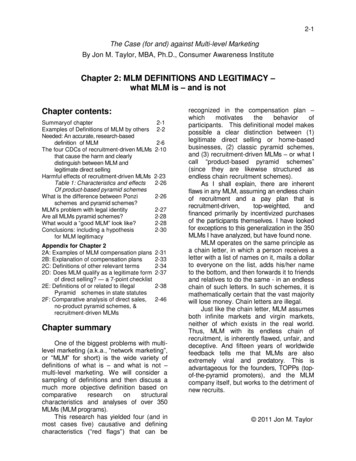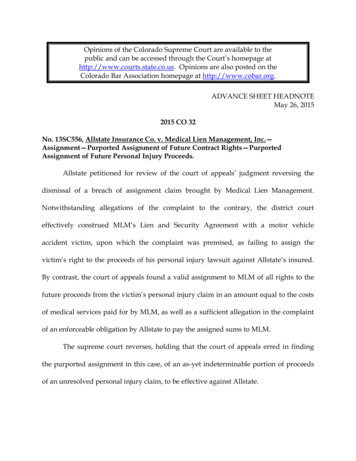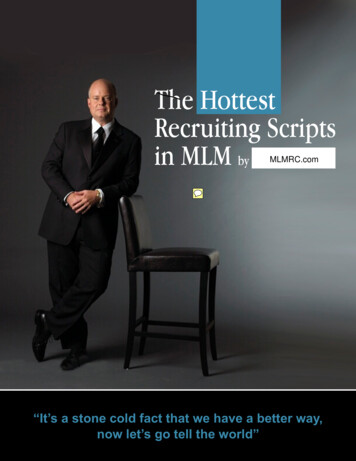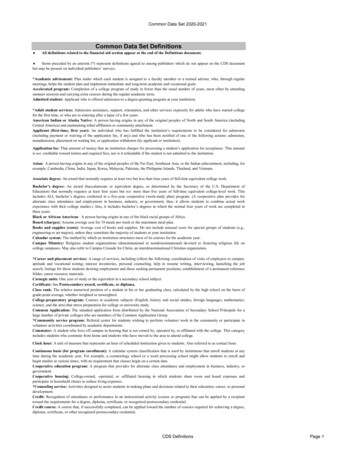
Transcription
2-1The Case (for and) against Multi-level MarketingBy Jon M. Taylor, MBA, Ph.D., Consumer Awareness InstituteChapter 2: MLM DEFINITIONS AND LEGITIMACY –what MLM is – and is notChapter contents:Summaryof chapterExamples of Definitions of MLM by othersNeeded: An accurate, research-baseddefinition of MLMThe four CDCs of recruitment-driven MLMsthat cause the harm and clearlydistinguish between MLM andlegitimate direct sellingHarmful effects of recruitment-driven MLMsTable 1: Characteristics and effectsOf product-based pyramid schemesWhat is the difference between Ponzischemes and pyramid schemes?MLM‘s problem with legal identityAre all MLMs pyramid schemes?What would a ―good MLM‖ look like?Conclusions: including a hypothesisfor MLM legitimacyAppendix for Chapter 22A: Examples of MLM compensation plans2B: Explanation of compensation plans2C: Definitions of other relevant terms2D: Does MLM qualify as a legitimate formof direct selling? — a 7-point checklist2E: Definitions of or related to illegalPyramid schemes in state statutes2F: Comparative analysis of direct sales,no-product pyramid schemes, &recruitment-driven -332-342-372-382-46Chapter summaryOne of the biggest problems with multilevel marketing (a.k.a., ―network marketing‖,or ―MLM‖ for short) is the wide variety ofdefinitions of what is – and what is not –multi-level marketing. We will consider asampling of definitions and then discuss amuch more objective definition based oncomparativeresearchonstructuralcharacteristics and analyses of over 350MLMs (MLM programs).This research has yielded four (and inmost cases five) causative and definingcharacteristics (―red flags‖) that can berecognized in the compensation plan –whichmotivatesthebehaviorofparticipants. This definitional model makespossible a clear distinction between (1)legitimate direct selling or home-basedbusinesses, (2) classic pyramid schemes,and (3) recruitment-driven MLMs – or what Icall ―product-based pyramid schemes‖(since they are likewise structured asendless chain recruitment schemes).As I shall explain, there are inherentflaws in any MLM, assuming an endless chainof recruitment and a pay plan that isrecruitment-driven,top-weighted,andfinanced primarily by incentivized purchasesof the participants themselves. I have lookedfor exceptions to this generalization in the 350MLMs I have analyzed, but have found none.MLM operates on the same principle asa chain letter, in which a person receives aletter with a list of names on it, mails a dollarto everyone on the list, adds his/her nameto the bottom, and then forwards it to friendsand relatives to do the same - in an endlesschain of such letters. In such schemes, it ismathematically certain that the vast majoritywill lose money. Chain letters are illegal.Just like the chain letter, MLM assumesboth infinite markets and virgin markets,neither of which exists in the real world.Thus, MLM with its endless chain ofrecruitment, is inherently flawed, unfair, anddeceptive. And fifteen years of worldwidefeedback tells me that MLMs are alsoextremely viral and predatory. This isadvantageous for the founders, TOPPs (topof-the-pyramid promoters), and the MLMcompany itself, but works to the detriment ofnew recruits. 2011 Jon M. Taylor
2-2When discussing issues about thelegitimacy of MLM in this book, I am usingthe word ―legitimate‖ in the broadest sense;i.e., ―conforming to recognized principles oraccepted rules or standards,‖1 as opposedto narrow legal definitions, which may ormay not conform to accepted standards inbusiness practices.This chapter concludes with likely theonly accurate real-world, research-based,and consumer friendly, definition of thebusiness model which is termed ―multi-levelmarketing:‖Multi-level marketing (MLM) is apurported income opportunity, in whichpersons recruited into a pyramid ofparticipants make ongoing purchases ofproducts and services, and recruitothers to do the same, and they stillothers, etc. – in an endless chain ofrecruitment and personal consumption,in order to qualify for commissions andbonuses and to advance upward in thehierarchy of levels in the pyramid.Product purchases become the means ofdisguising or laundering investments inwhat is in fact a product-based pyramidscheme.Based on my research that will beexplained in later chapters, I would add thefollowing:Typically, prospects are lured into thescheme with exaggerated product andincome claims. And because the pay planis heavily stacked in favor of those at thehighest levels in the pyramid, the vastmajority of participants spend more thanthey receive and eventually drop out, onlyto be replaced by a stream of similarlymisled recruits, approximately 99% ofwhom are likewise destined to experienceloss and disappointment.A problem of definitions. Muchconfusions exists on the subject of what is –and is not – multi-level marketing (MLM)and how it can be distinguished from illegalpyramid schemes. We will begin by looking1The New Merriam Webster Dictionary, Springfield,MA, 2008at how others define it and then bringtogether what light can be shed on thesubject from legal and regulatory sourcesand from recent research.We will first look at the definitions ofmulti-level marketing offered by othersExamples of Definitions of MLMby others – with commentaryFrom Wikipedia (March 2010):Multi-levelmarketing(MLM), (also called networkmarketing, direct selling,referralmarketing,andpyramid selling) is a termthat describes a marketingstructure used by some companies as partof their overall marketing strategy. Thestructure is designed to create a marketingand sales force by compensating promotersof company products not only for sales theypersonally generate, but also for the salesof other promoters they introduce to thecompany,creatingadownlineofdistributors and a hierarchy of multiplelevels of compensation in the form of apyramid.The products and company are usuallymarketed directly to consumers andpotential business partners by means ofrelationship referrals and word of mouthmarketing.―Independent, unsalaried salespeopleof multi-level marketing, referred to asdistributors (or associates, independentbusiness owners, dealers, franchise owners,sales consultants, consultants, independentagents, etc.), represent the company thatproduces the products or provides theservices they sell. They are awarded acommission based upon the volume ofproduct sold through their own sales effortsas well as that of their downline organization.Independent distributors develop theirorganizations by either building an activecustomer base, who buy direct from thecompany, or by recruiting a downline ofindependent distributors who also build acustomer base, thereby expanding theoverallorganization.Additionally,distributors can also earn a profit byretailing products they purchased from thecompany at wholesale price.
2-3MLM spokesmen clearly crafted thisdefinition, which Wikopedia uncriticallyaccepted in lieu of definitions of consumeradvocates that would highlight the inherentflaws in MLM. For example, no mention ismade of the endless chain of recruitmentand a pay plan that is recruitment-driven,top-weighted, and financed primarily byincentivized purchases of the participantsthemselves. These critical features will beexplained later in this chapter.From author Richard Poe:Network marketing is not defined inany standard dictionary of business terms.Nor do network marketers themselvesagree on what it means. For lack of anyclear standard, I suggest the followingdefinition: ―Any method of marketing thatallows independent sales representatives torecruit other sales representatives and todraw commissions from the sales of those2recruits.‖This overbroad definition would take inmany sales organizations that are notconsidered MLM, such as some insuranceand real estate agencies. And as with theWikopedia definition, no mention is made ofthe inherent flaws in any MLM system - theendless chain of recruitment and a pay planthat is recruitment-driven, top-weighted, andfinanced primarily by incentivized purchasesof the participants themselves.Zig Ziglar (with Dr. John Hayes)offers his ―technical definition‖ of whathe claims network marketing (MLM) is –and is not. Below is aninteresting definition put forthby Dr. John Hayes, incooperation with prominentsalesmanship author Zig Ziglar,3who incidentally makes nomention of MLM or networkmarketing in his books directedtoprofessionalsalesmen: Salesmanshipauthor Zig Ziglar2 Wave 3: The New Era in Network Marketing, byRichard Poe (Prima Publishing: New York, 1995), p.7-83 Network Marketing for Dummies, by Zig Ziglar withJohn P. Hayes, Ph.D. (Hungry Minds, Inc.: New York,NY, 2001), p. 2Would you like a technical definition?Network marketing is a system for distributinggoods and services through networks ofthousands of independent salespeople, ordistributors. The distributors earn money byselling goods and services and also byrecruiting and sponsoring other salespeoplewho become part of their downline, or salesorganization. Distributors earn monthlycommissions or bonuses on the salesrevenues generated by their downline.Here‘s what network marketing is and is not:Network marketing, or multi-levelmarketing (MLM), isn‘t illegal,fraudulent, or unethical.Network marketing isn‘t an opportunity to get rich quick off thepayments of others who join the organization. That‘s a pyramid scheme.Network marketing isn‘t a pyramidscheme, which is illegal and unethical.Networkmarketingisn‘tanopportunity to get rich quick. Period.Network marketing isn‘t built onsimple mathematics where manylosers pay a few winners. That‘s alsoa pyramid scheme.Network marketing isn‘t just forsalespeople.Network marketing isn‘t expensive.Unlikemostotherbusinessopportunities, the start-up costs arelow, almost always less than 500and often under 100.Network marketing isn‘t a way forcompanies to sell huge amounts ofinventory to distributors. Networkmarketingisn‘tawayfordistributors to sell stuff that nobodywants or uses.Network marketing isn‘t a license tosell products and services atinflated prices.Network marketing isn‘t for peoplewho aren‘t willing to work hard.Network marketing isn‘t for anyonewho can‘t or won‘t follow a provensystem that leads to businesssuccess.While the first paragraph is quitedescriptive and somewhat accurate, as isthe Wikopedia definition, no mention ismade of the inherent flaws in MLM - theendless chain of recruitment and a pay planthat is recruitment-driven, top-weighted, andfinanced primarily by incentivized purchases
2-4of the participants themselves. Thesecritical features will be explained later.Also, most of the items on the list ofwhat network marketing is not would bevigorously challenged by knowledgeableexperts advocating for consumers, based onextensive research as reported on the web site– www.mlm-thetruth.com.Other authors on multi-level marketingoffer weak definitions – or don’t evenattempt to define MLM.Another prominent MLM author,Dr. Charles King, professor ofmarketing at the University ofIllinois at Chicago (with JamesRobinson), offers an evenweaker definition that would bealmost useless in making suchdistinctions:Dr. Charles KingNetwork marketing is the low-cost, andnow high-tech, industry that invites you tobuild your own business and earn apotentially high income while working fromhome on your own schedule. You earnimmediate income and serious long-termresidual income by selling products andservices directly to consumers and4convincing others to do the same.people process may be continued through5one or more levels of earnings.A search through the business sectionof a local Barnes and Noble store revealsthat other authors have written on how to besuccessful at network marketing6, butwithout offering any substantive definition ofwhat they are talking about at all, apparentlyassuming readers all know precisely whatthey are talking about. This may besomewhat true of veteran MLM participants,but feedback I have received worldwide tellsme this assumption may not always becorrect, especially for those being recruitedfor the first time.The FTC chooses a definition ofmulti-level marketing that only createsconfusion.Inits2008announcement by the FTC of itsRevised Proposed BusinessOpportunity Rule (RPBOR),exempting MLM from having tocomply with the Rule, the FTCquoted an article in which the followingdefinition was advanced:Multi-level marketing is one form ofdirect selling, and refers to a business modelin which a company distributes productsthrough a network of distributors who earnincome from their own retail sales of theproduct and from retail sales made by thedistributors‘ direct and indirect recruits.Because they earn a commission from thesales their recruits make, each member in theMLM network has an incentive to continuerecruiting additional sales representatives intotheir ―down lines.― - Peter J. Vander Nat andWilliam W. Keep, “Marketing Fraud: AnApproachtoDifferentiatingMultilevel7Marketing from Pyramid Schemes,”Again, as with the Wikopedia definition,no mention is made of the inherent flaws inany MLM system – an endless chain ofrecruitment and a pay plan that isrecruitment-driven,top-weighted,andfinanced primarily by incentivized purchasesof the participants themselves.As an example of other authors who havemade weak attempts to define multi-levelmarketing, David Roller suggests a definitionthat is rosy and descriptive, but not very helpfulin making clear distinctions between MLM andother home-based businesses:Multi-level marketing or networkmarketing is a system by which a parentcompany distributes its services or productsthrough a network of independent businesspeople, not only in the United States butthroughout the world. These independentbusiness people or entrepreneurs thensponsor other people to help them distributethe product or service. This people-helping4King, Charles W. and Robinson, James W., TheNew Professionals: The Rise of Network Marketing asthe Next Major Profession, Three Rivers Press, 20005 Roller, David, How to Make Big Money in Multi-levelMarketing, Prentice Hall, 19896 One example is The Ultimate Guide to NetworkMarketing: 37 Top Network Marketing IncomeEarners Share their Most Preciously Guarded Secretsto Building Extreme Wealth, edited by Joe Rubino.John Wiley & Sons, Inc., 2006. Another book is byMLM promoters Yarnell, Mark, and Reid, Rene, YourFirst Year in Network Marketing: Overcome YourFears, Experience Success, and Achieve YourDreams!” Three Rivers Press, 1998.721 Journal of Public Policy & Marketing (Spring2002), (―Vander Nat and Keep‖), p. 140. (Cited inFootnote 34 at bottom of page 15 of RPBOR)
2-5At a workshop hearing on the form forthe final Rule, I pointed out that almost anydirect selling company could circumvent theRule by paying commissions to two or morelevels of sales persons, who would have insome way been involved in recruiting newsales persons. In fact, many salesorganizations do this, but do not considerthemselves ―multi-level marketing.‖With this definition, together with theMLM exemption, the proposed Rule wouldbe almost totally ineffective in curbingabuse. It would be a tacit admission by theFTC that it is giving up on its mission toprotect consumers against ―unfair anddeceptive practices‖ in this very importantarena. As will be seen from further analysis,it would be difficult to conceive of a moreunfair and deceptive practice than MLM, tosay nothing of its extremely viral andpredatory nature.Again, in this FTC definition, as with theWikopedia definition, no mention is made ofthe inherent flaws in any MLM system – anendless chain of recruitment and a pay planthat is recruitment-driven, top-weighted, andfinanced primarily by incentivized purchasesof the participants themselves.The DSA attempts to define MLM as―direct selling.‖ The DSA (Direct SellingAssociation) was once an organizationdedicated to advancing the interests of whatwere then legitimate direct sellingcompanies like Fuller Brush and WorldBook Encyclopedia. But what has happenedin recent decades could be illustrated by afarmer who has pigs and horses for sale. Hegets more money for horses, so he attacheshorse hairs on the buttocks of the pigs andmarches them into the horse corral andproclaims, "See there, they are no longerpigs, but horses - because they are in thehorse corral."Pigs are not horses!Similarly, since ―multi-level marketing‖sounded too much like a pyramid scheme,MLM promoters coined the term "networkmarketing." Then, since it would sound evenless pyramid-like, they sought to be called"direct selling" companies. So one by one,MLMs joined the Direct Selling Associationand now boldly declare that they are ―directselling companies,‖ since they are membersof the DSA.8 The DSA now divides itsmembership into ―single level‖ and ―multilevel‖ pay plans.TheDirectSellingAssociation, has in recentyears lobbied aggressivelyfor the MLM industry to stopor water down proposed orexisting legislation that protects consumersagainst what I call ―product-based pyramidschemes‖; i.e., MLMs. They also work todefeat efforts of consumer advocates towarn against product-based pyramidschemes, and to convince the public andthe media of the legitimacy of MLM and oftheir stated intent to protect the public fromunethical practices.In 2006, the FTC proposed a BusinessOpportunity Rule, which would requiresellers of business opportunities to disclosecertain information to protect consumers.The excerpt below is taken from commentsthe DSA submitted, objecting to includingMLMs in the Rule. The DSA‘s efforts toequate MLM with legitimate direct sellingand to justify its exclusion from the Rule arespelled out, as is their definition of MLM:DSA defines direct selling as: The saleof a consumer product or service, in a faceto-face manner, away from a fixed retaillocation. . .Multilevel marketing, also known asnetwork marketing, is a compensationstructure, not a sales strategy. In amultilevel compensation plan, independentconsultants are compensated based notonly on one‘s own product sales, but on theproduct sales of one‘s downline (thoseindividuals the direct sales-person hasrecruited, or recruits of recruits.)In contrast, in a single levelcompensation plan, independent consultants are compensated based solely on8See the section ―The DSA/MLM cartel‖ in Chapter10
2-6one‘s own product sales. Companies usinga multilevel compensation structure mayuse either a person-to-person or party plansales strategy. Eighty-four percent of directselling firms use some form of multilevelcompensation, and virtually all newcompanies entering direct selling are using9some form of multilevel compensation.Another statement in the DSAcomments is remarkable: “Recruiting is thelifeblood of the industry.” This is a startlingadmission of the focus on recruitment,which is true of all product-based pyramidschemes. My analysis of the compensationplans of over 350 MLMs, including DSA firms,confirms this. Comparatively slight rewards forretailing, together with overpriced products,makes recruiting the focus of anyone seekingto profit from MLM.The suggestion that ―the vast majorityof salespeople work[ing] only a few hoursper week, with modest financial goals inmind‖ will be found in subsequent chaptersto be totally misleading because one cannotbuild and maintain a large downline workingpart-time, seasonally, or with modestfinancial goals. Virtually all who do MLMpart-time lose money, after subtractingexpenses, including purchase of productsnecessary to qualify for commissions.And again, as with the Wikopediadefinition, no mention is made of the inherentflaws in any MLM system – an endless chainof recruitment and a pay plan that isrecruitment-driven, top-weighted, and financedprimarily by incentivized purchases of theparticipants themselves. These critical featureswill be explained later in this chapter.Needed: A more accurate,research-based definition ofMLM that addresses structuralflaws in the model – and harm -driven MLM‖ (implying anemphasis of recruitment over selling) and―Product-based Pyramid Scheme‖10 asinter-changeable terms. These programshave also been called ―Multi-levelMarketing,‖ ―Network Marketing,‖ etc. –even ―direct selling‖ (though little selling tothe public takes place). ―MLM‖ is a genericacronym for any type of multi-level orendless chain selling program, and we willuse it for brevity.More negative sounding titles repreneurial chains,‖ etc. In this report, a―recruitment-basedMLM‖employsacompensation plan that rewards recruiting somuch more than direct selling that there iscomparatively little incentive to sell products.No-product pyramid schemes are fairlyeasy to identify, and they seldom last longwithout law enforcement shutting themdown. But when products are offered, andwhen consumers are presented with anincome ―opportunity‖ with multiple levels of―distributors,‖ it is not easy for some todecide whether or not it is in fact anexploitive product-based pyramid scheme.Unfortunately, some of the most damagingprograms manage to escape legal action.After processing extensive data andanalytical reports and posting them on a website, I found myself interactingwith the top experts in the field.I began offering research andtraining through the non-profitConsumer Awareness Institutethat I had formed years earlierfor other projects – all financedout of my own pocket.9#178 FTC Matter No.: R11953 16 CFT Part 437NoticeofProposedRulemaking:BusinessOpportunity Rule, Comments #522418-12055, -58, 61, -66, -70, -74, -79, -83,-87, -92, and -9610For a brief history of classic, no-product pyramidschemes, and MLM, or product-based pyramidschemes, see Chapter 10.
2-7FTC rationale for consideringpyramid schemes unlawful. The FederalTrade Commission Act states that ―Unfairmethods of competition in or affectingcommerce, and unfair or deceptive acts orpractices in or affecting commerce, arehereby declared unlawful.‖11 While the FTCdoes not specifically address pyramidschemes, such schemes have beendeemed unlawful under the above clause inthe Federal Trade Commission Act.12―. . . unfair or deceptive acts orpracticesinoraffectingcommerce, are hereby declaredunlawful.‖ While the FTC does notspecificallyaddresspyramidschemes, such schemes havebeen deemed unlawful under theabove clause in the Federal TradeCommission Act (Section 5).MLMs are typically recruitmentdriven. I refer to MLMs which recruitaggressively as ―recruitment-driven MLMs,‖as opposed to hypothetical ―retail-focusedMLMs,‖ which would allow a person to earna significant income from retailing productsto end users. Understanding the differenceis the key to identifying the features in MLMthat cause harm to participants – which willbe explained in later chapters. Actually,harmless MLMs would be extremely rare. Infact, I found no retail-focused MLMs out ofhundreds of MLMs I have reviewed.Party plans do some retailing. Theclosest to a retail-focused MLM would be an―in-home demonstration‖ program, or ―partyplan,‖ which features sales at partiessponsored by demonstrators. But determiningwhether or not the party plan is stillrecruitment-driven and financed primarilythrough purchases by participants wouldrequire analysis of their compensation plansand average earnings data, which such11Section 5(a)(1) of the Federal Trade CommissionAct, 15 U.S.C. 45(a)(1)12In re Koscot Interplanetary, Inc., 86 F.T.C. 1106(1975)companies have not as yet been willing toprovide. So they remain a grey area in myresearch.In-home demonstration programs(―party plans‖)Confusing comparisons. MLM isoften compared to legitimate alternativebusiness models, such as franchising, directsales,insurance,andproductdistributorships. This adds confusion in theminds of consumers and law enforcementofficials. However, my research suggeststhat clear differences can be seen.As explained above, one commonstrategy for MLM companies seeking tobuild credibility is to go to great lengths tobe identified as ―direct sales‖ organizations.However, after rigorous comparisons oflegitimatebusinessmodelswithcharacteristics of compensation plans of―recruitment-driven MLMs‖, when the fourcharacteristics described below are takentogether,cleardistinctionsbetweenlegitimate and illegitimate (using the FTCstandard of ―unfair and deceptive practices‖).Interestingly, the four characteristics,which when taken together differentiate theseprograms from legitimate businesses, are thesame features that cause an extremely highloss rate and other problems for participants. Icall them ―causal and defining characteristicsof product-based pyramid schemes‖ becausethey both cause the harm and also serve todefine MLMs as product-based pyramidselling schemes, or recruitment-driven MLMs.Properly applied, they can also be highlyeffective in identifying programs that violatefederal and state laws against pyramidschemes.
2-8Inadequate legal definitions. Most ofthe laws and statutes were crafted before thestructure, dynamics, and effects of productbased pyramid schemes were fullyunderstood,sothedefinitions within antipyramid statutes do notaccurately reflect the rootcauses of the problems.They tend to focus onbehavior of participants, rather than onobjective underlying structural features.However, there is enough validity in thepresent legal definitions of pyramid schemesin most jurisdictions that enforcement againstsuch schemes can be effective if theprinciples in this paper are understood andapplied. This is true regardless of thecomplexity of the compensation plan of anygiven MLM.FTC guidelines and most state statutesinclude a key element in defining pyramidschemes – the payment of money by thecompany in return for the right to recruit otherparticipants into the scheme. If the primaryemphasis is compensation from recruiting,rather than from the sale of products to endusers, it is considered a pyramid scheme.How such primary emphasis is to bedetermined has until now been a formidablechallenge for investigators.Why understanding the compensation plan is so important. Decades ago,psychologists experimenting with bothanimals and people learned that you get thebehavior you reward. For example, if youplace a dog in a room with two bowls, thefirst containing a pound of beef, and thesecond an ounce of dry dog food, invariablythe dog will choose to eat from the first bowl.You get the behavior you reward.Similarly, since an MLM compensationplan specifies how participants are rewarded,it reveals whether the primary incomeemphasis is on recruiting or on retailing –and therefore, whether or not a given MLMis a disguised pyramid scheme.MLM spokesmen maneuver to divertauthorities from examining how participantsare rewarded. They speak of the validity ofa company‘s products, the integrity of itsleaders, and the company‘s solid financialcondition. It seems that the one thing MLMleaders do not want regulators tounderstand – the compensation plan – isthe one thing investigators must grasp inorder to answer the question of where theemphasis is – on company payout resultingprimarily from recruiting (or product sales torecruits), or primarily from retailing toconsumers outside of the MLM‘s network ofparticipants.The problem of evaluating MLMprograms is further complicated by a widearray of complex MLM payout formulas, orcompensation plans. The problem ofidentifying emphasis on recruiting vs.retailing in a compensation plan, as well asconsumer harm, can be greatly simplified byunderstanding the four characteristicsdiscussed below – all of which are generic toall MLMs, or product-based pyramidschemes. (There is also a fifth characteristicthat appears in almost all MLMs whichamplifies the fourth characteristic.)MLM compensation plans can getquite complex. Appendix A illustrates justtwo examples out of hundreds of MLMcompensationplans,showingthecomplexity of only a portion of a typicalMLM compensation plan. Many of the plansare far more extensive and complex thanthese. This makes it difficult to compareplans from different MLMs. These widelyvarying plans also illustrate the need for anunderstanding of the commonalities anddistinguishing features that separate MLM fromall other forms of business activity.
2-9These widely varying pay plans stinguishingfeatures that separate MLM from allother forms of business activity.What is the difference il-focusedMLMs?Companies with all four of the followingcharacteristics of a product-based pyramidscheme can be classified as recruitmentdriven MLMs, as differentiated fromhypothetical retail-focused MLMs, whichwould primarily reward those who sellproducts. In reality, MLMs (with theexception of some party plans) areessentially closed systems, which sellproducts at retail primarily to programparticipantsandcooperatingfamilymembers – seldom to the general public.These product purchases could beconsidereddisguisedorlaunderedinvestments in a product-based ounders,andcompanyexecutives are rewarded at the expense ofa revolving door of unwitting recruits.How these defining characteristicswere derived. Fifteen years of research andfeedback confirm this analysis, including aone-yearexperientialtest,directobservations of numerous MLM opportunitymeetings, communications with thousands ofparticipants (and ex-participants) andexecutives from a variety of MLMs – and withconsumers as MLM prospects, consultationswith top MLM experts and attorneys,collection/ processing of available data(including official company reports), analysisof over 350 MLMs with all types ofcompensation plans, and surveys of taxprofessionals.In the early stages of my research, aftermonths of comparative analysis, I was ableto identify a list of characteristics that arecommon to all MLMs, includin
multi-level marketing offered by others Examples of Definitions of MLM by others - with commentary From Wikipedia (March 2010): Multi-level marketing (MLM), (also called network marketing, direct selling, referral marketing, and pyramid selling) is a term that describes a marketing structure used by some companies as part










